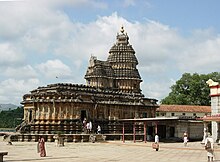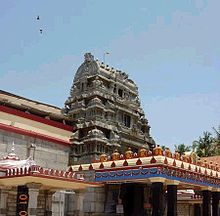Sringeri Sharada Peetham
| Vidyashankara Temple at Shringeri | |
|---|---|
ವಿದ್ಯಾ ಶಂಕರ ದೇವಸ್ಥಾನ | |
 | |
| Religion | |
| Affiliation | Hinduism |
| District | Chikkamagaluru |
| Deity | Vidya Shankara |
| Location | |
| Location | Sringeri |
| State | Karnataka |
| Country | India |
| Geographic coordinates | 13°25′11″N 75°15′24″E / 13.4198°N 75.2567°E |
| Architecture | |
| Creator | Adi Shankara |
| Completed | 820 AD |
| Website | |
| https://www.sringeri.net/ | |
| Sringeri Sharadha Temple | |
|---|---|
ಶೃಂಗೇರಿ ಶಾರದಾ ದೇವಸ್ಥಾನ | |
 | |
| Religion | |
| Affiliation | Hinduism |
| Deity | Sharadhe |
| Part of a series on |
| Advaita |
|---|
 |
|
|
Sringeri Sharada Peetham is the southern Advaita Vedanta matha or monastery established by Adi Shankara in 8th century AD. The matha is on the banks of the Tunga River in Chikkamagalur district, Karnataka, India, 105 kilometers from Mangaluru and 303 kilometers from the state capital, Bengaluru.
History
Early history
Traditionally, Adi Shankara (8th century) is regarded as the greatest teacher and reformer of the Smartha.[1] According to Alf Hiltebeitel, Shankara established the nondualist interpretation of the Upanishads as the touchstone of a revived smartha tradition.[2] The Sringeri Sharada monastery founded by Shankara in Karnataka is still the centre of Smartha tradition.[citation needed]
Sankara is believed to have envisioned this place as the holy site where a snake unveiled his hood like a umbrella to protect a frog from the hot sun. According to tradition, it is one of four major temples established by Sankara.[3]
As per Hindu legend, the place is associated with sage Rishyasringa, son of Vibhandankamuni. He did severe penance at this place, leading to the name Sringeri. The temple was renovated during the regime of Vijayanagara Empire during the 14-16th centuries and later during 1916.[3]
Sureshwaracharya, who was Maṇḍana Miśra in his purvashrama,[4][5] was installed as the successor of Shankaracharya before the latter resumed his tour to found his three pithas at Puri, Dwaraka and Badrinath.[citation needed]
Maratha sacking
During the Maratha–Mysore War in 1791, Parasuram Bhau of the Maratha Empire marched on Bednur. His irregular horsemen commanded by a Patwardan foolishly plundered Sringeri. They raided the temple and matha of the Sharada Peetham, killing and wounding many people including Brahmins, plundering the monastery of all its valuable possessions, and desecrating the temple by displacing the image of goddess Sharada. The Shankaracharya petitioned Tipu Sultan for help. A collection of about 30 letters written in Kannada, which were exchanged between Tipu Sultan's court and the Shankaracharya were discovered in 1916 by the Director of Archaeology in Mysore. Tipu Sultan expressed his indignation and grief at the news of the raid:[6][7][8]
"People who have sinned against such a holy place are sure to suffer the consequences of their misdeeds at no distant date in this Kali age in accordance with the verse: "Hasadbhih kriyate karma rudadbhir-anubhuyate" (People do [evil] deeds smilingly but suffer the consequences crying)."[9]
Tipu Sultan immediately ordered the Asaf of Bednur to supply the Swami with 200 rahatis (fanams) in cash and other gifts and articles. The Marathas were remorseful. They recovered and returned most of the valuables, although some were lost.[10]
Tipu Sultan's interest in the Sringeri temple continued for many years.
Modern history
Vidushekara Bharathi was appointed as Uttaradhikari of the Sringeri Sharadha Peetham by Bharati Thirtha on 23 January 2015.[11] The last five Jagadgurus were:
| Name | Years as Jagadguru | Place of birth | Purvashrama name[12] |
|---|---|---|---|
| Sacchidananda Shivabhinava Nrusimha Bharati | 1872–1912 | Mysore | Shivaswami |
| Chandrasekhara Bharati III | 1912–1954 | Sringeri | Narasimha Sastri |
| Abhinava Vidyatirtha | 1954–1989 | Bangalore | Srinivasa Sastri |
| Bharati Tirtha | 1989 – present | Narasaraopet | Tangirala Sitarama Anjaneyulu |
| Vidhushekhara Bharati | 2015 - present | Tirupathi | Kuppa Venkateshwara Prasad Sharma[13] |
See also
References
- ^ Rosen 2006, p. 166.
- ^ Hiltebeitel 2002, p. 29.
- ^ a b Harshananda, Swami (2012). Hindu Pilgrim centres (2nd ed.). Bangalore, India: Ramakrishna Math. p. 135-8. ISBN 81-7907-053-0.
- ^ Roodurmum 2002, p. 29.
- ^ Kuppuswami Sastri 1984.
- ^ "Sri Sacchidananda Bharati III (1770 - 1814) - Sringeri Sharada Peetham". Sringeri Sharada Peetham. Retrieved 2017-11-09.
- ^ Mohibbul Hasan, History of Tipu Sultan, p. 358
- ^ Vikram Sampath. "Why we love to hate Tipu Sultan". www.livemint.com/.
- ^ Annual Report of the Mysore Archaeological Department 1916 pp 10–11, 73–6
- ^ Uday S. Kulkarni (3 December 2015). "What Exactly Happened At Sringeri Math In April 1791?". Swarajya. Retrieved 2017-10-23.
- ^ http://www.sringeri.net
- ^ Purvashrama name refers to the name of the Jagadguru before taking Sannyasa.
- ^ Deccan Herald, Sringeri seer appoints successor
Sources
- Hiltebeitel, Alf (2002). Hinduism. In: Joseph Kitagawa, "The Religious Traditions of Asia: Religion, History, and Culture". Routledge.
{{cite book}}: Invalid|ref=harv(help) - Kuppuswami Sastri, S. (1984), Brahmasiddhi, by Maṇḍanamiśra, with commentary by Śankhapāṇī. 2nd ed., Delhi, India: Sri Satguru Publications
- Roodurmum, Pulasth Soobah (2002), Bhāmatī and Vivaraṇa Schools of Advaita Vedānta: A Critical Approach, Delhi: Motilal Banarsidass Publishers Private Limited
- Rosen, Steven (2006), Essential Hinduism, Greenwood Publishing Group

